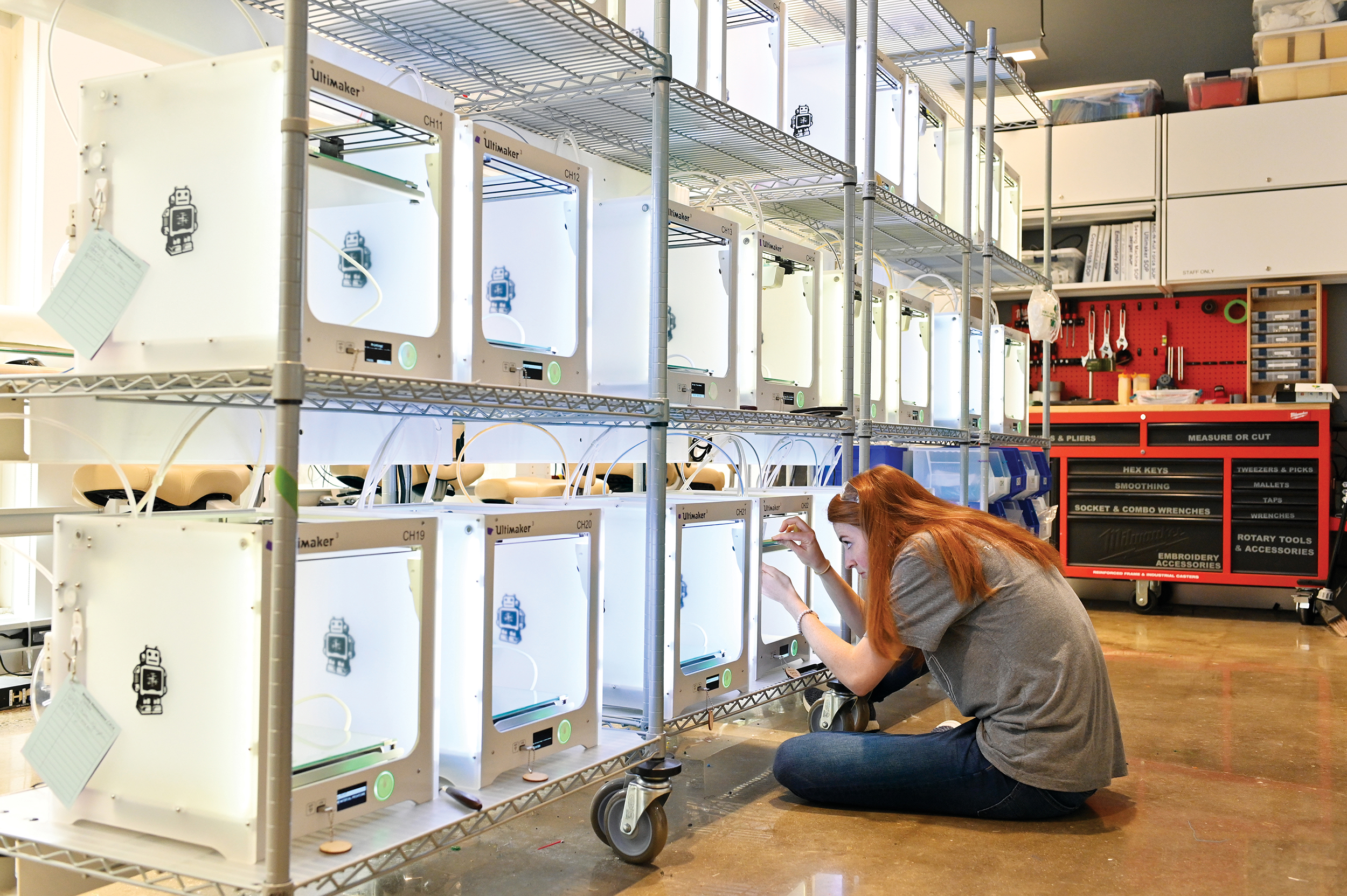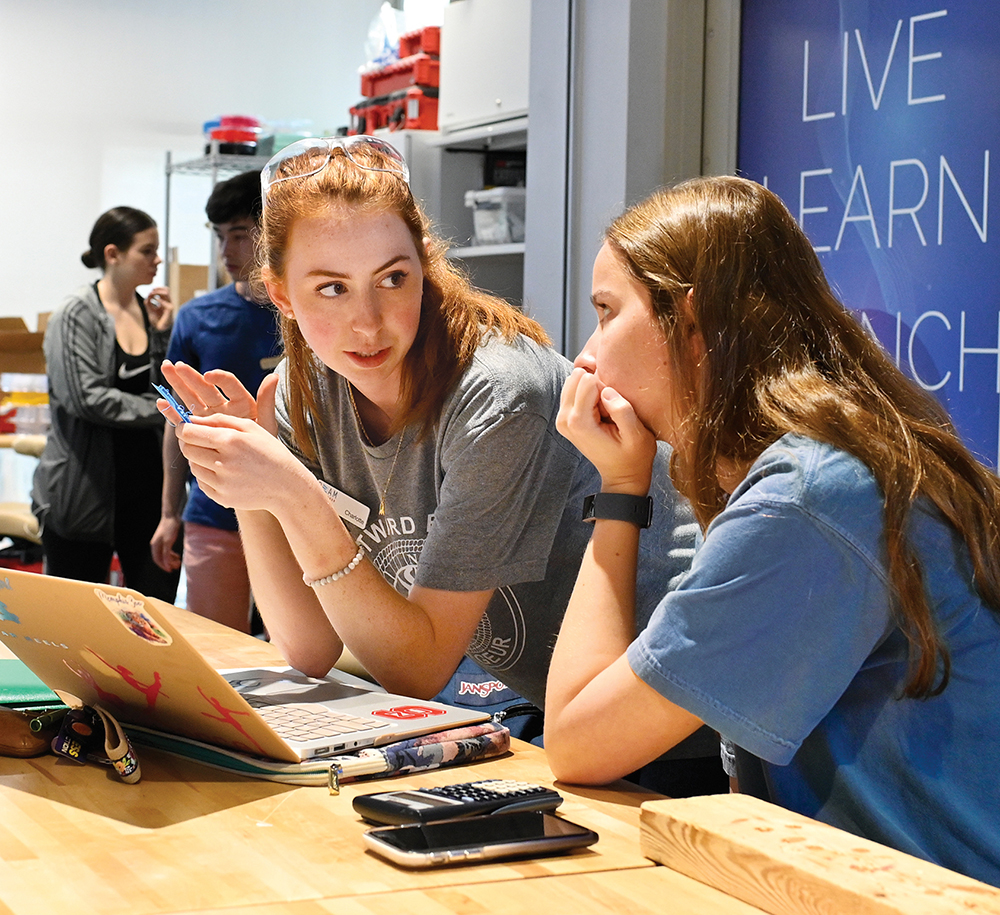The BeAM School of Engineering
Posted on July 1, 2019
Charlotte Dorn arrives an hour early to clean 3D printers and check on in-progress projects in the Carmichael lab. (Photo by Grant Halverson ’93)
Of the 15 colleges Charlotte Dorn was considering, only Carolina didn’t offer the mechanical engineering degree she wanted. The High Point native’s family had a good laugh about that.
She had competed nationally with her high school robotics team, helped build autonomous driving carts for a Colorado startup as a teenager and counted a Stephen Hawking title as her favorite children’s book. They told her she’d probably end up in Chapel Hill.
Then Dorn won a Morehead-Cain Scholarship, and the choice was no joke: Should she pass up a prestigious honor that also made financial sense? Or leave engineering behind, let dust settle on the bins of deconstructed electronics she had at home?
More BeAM coverage
The Student Body Shop
The Art of Perseverance
Can I Make You Something From the Davie Poplar?
The answer turned out to be neither. Because when Dorn visited campus for a tour, the student who had idolized Leonardo da Vinci since fourth grade heard something about a makerspace.
“I skipped whatever I was supposed to be doing and said, ‘I need to go there,’ ” said Dorn, who also had toured makerspaces at Duke, Case Western and Olin College of Engineering in Boston. “Immediately, I knew I would spend my four years in this space. Even without an engineering program, there’s still this really cool community of makers here. I knew I’d be able to find students who have similar interests — who like building and working with their hands and putting things together.”
That’s music to Rich Superfine’s ears. BeAM may have gotten its start as a way to fill a void in practical skills on campus, but for Superfine, the Taylor-Williams Distinguished Professor of physics and astronomy at UNC, the makerspace network represents something even bigger: the chance to refine Carolina’s image.

Dorn, who chose Carolina over other schools after seeing the BeAM spaces, also helps train students in using the equipment. (Photo by Grant Halverson ’93)
“We don’t have an engineering school,” he said. “But we do have a technology and engineering enterprise. We are a $1 billion annual research expenditures university. We are the fifth-largest federally funded research enterprise in the country. We are a technology powerhouse, yet it is not really captured effectively on campus. It’s not completely embraced as our identity.”
Carolina has many departments that feed that identity, including biomedical engineering, environmental sciences and engineering, computer science and the relatively new applied physical sciences, Superfine said. But BeAM’s presence gives these disciplines a kind of spotlight they didn’t always have.
“The makerspaces are a way of making that technology and engineering pursuit most evident on campus, bringing it all out of the red brick buildings and making communal spaces that people can come to and really engage in new kinds of solutions. BeAM is making how good we are more apparent, even to ourselves.”
Dorn, a computer science major and rising sophomore, said she’s happy with her choice. She’s the builder on a robotics racing vehicle team with three doctoral students and was part of an interdisciplinary course in which she helped design and construct a “recycle-bot” that would turn the scraps of 3D-printing projects at BeAM into reusable filament — among other projects.
And she’s found new interest in the ethics of artificial intelligence, a development she credits to “that nice Chapel Hill value of liberal arts.”
“The fact that she won’t come out with an actual mechanical engineering degree won’t matter at all,” said Glenn Walters ’05 (PhD), director of UNC’s Environmental Sciences and Engineering Design Center. “If she shows what she’s done, it’s going to be worth way more than most engineering degrees.”
If Dorn has a complaint so far, it’s a common one — avoiding the snooze button when she needs to go to class. No problem, though: She just went to BeAM, where she built a Rubik’s Cube alarm clock that she calls “the perfect combination of cruel and effective.” (The alarm only turns off when the puzzle is solved.)
“It’s crazy,” Dorn said, “how much robotics and mechanical engineering I’ve ended up doing at a liberal arts school.”
— Beth McNichol ’95
Thanks for reading the Carolina Alumni Review
Carolina Alumni members, sign in to continue reading.
Not yet a member? Become one today.
